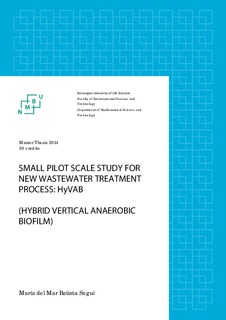| dc.description.abstract | Due to strict pollutant discharge limits the wastewater industry faces the challenges to find more effective treatments but without increasing energy, space requirements or operational cost, especially for industrial wastewater with high amount of pollutants, such as chemical oxygen demand (COD). Conventional biological treatments have shown good treatment efficiency for this type of industrial wastewater, but these systems have operational limitations (large space requirements, no possibility of biogas collection or long retention times). High rate integrated bioreactors are able to overcome these limitations. This type of reactor combines wastewater processes in a single bioreactor unit that are normally done in separate steps.
The objective of this study is to investigate the start-up and the treatment performance of the novel high rate aerobic–anaerobic reactor called the Hybrid Vertical Anaerobic Biofilm (HyVAB). The reactor operates as a single treatment unit consisting in two chambers connected vertically. The upper chamber is working using Continuous Flow Intermittent Cleaning (CFIC) system, which is a technology developed by Biowater AS, and the lower chamber incorporates the Up Flow Anaerobic Sludge Blanket (USAB) technology. HyVAB offers important improvements for biological wastewater treatment systems. These are: less space requirements, lower sludge production and biogas collection without compromising the COD removal treatment efficiency. The biogas can be used as a renewable source of energy.
The study was carried out with two different sized pilot scale reactors placed in different locations treating high strength wastewater (COD >10.000 mg/L) sourced from Norsk Spesialolje (NSO), Kambo (Norway). The main findings are that the start-up was accomplished in only 20 days. During the 20 days, HyVAB exhibited treatment efficiencies with an average of 82% COD removal and attaining 97% after three months of operation. The reactor also recovered fast after periods of organic overloads The results make this reactor a worthy candidate for further studies of economic feasibility and in steady state operations. | nb_NO |
